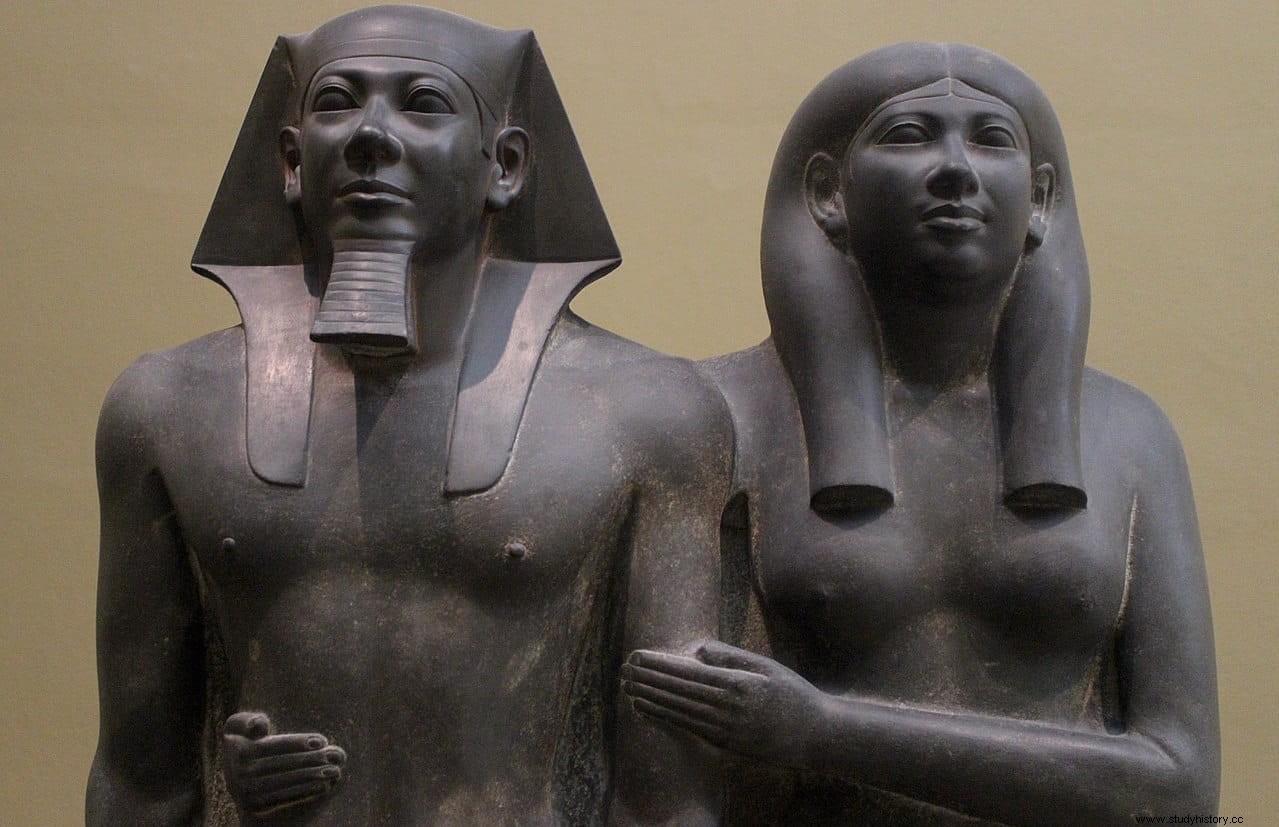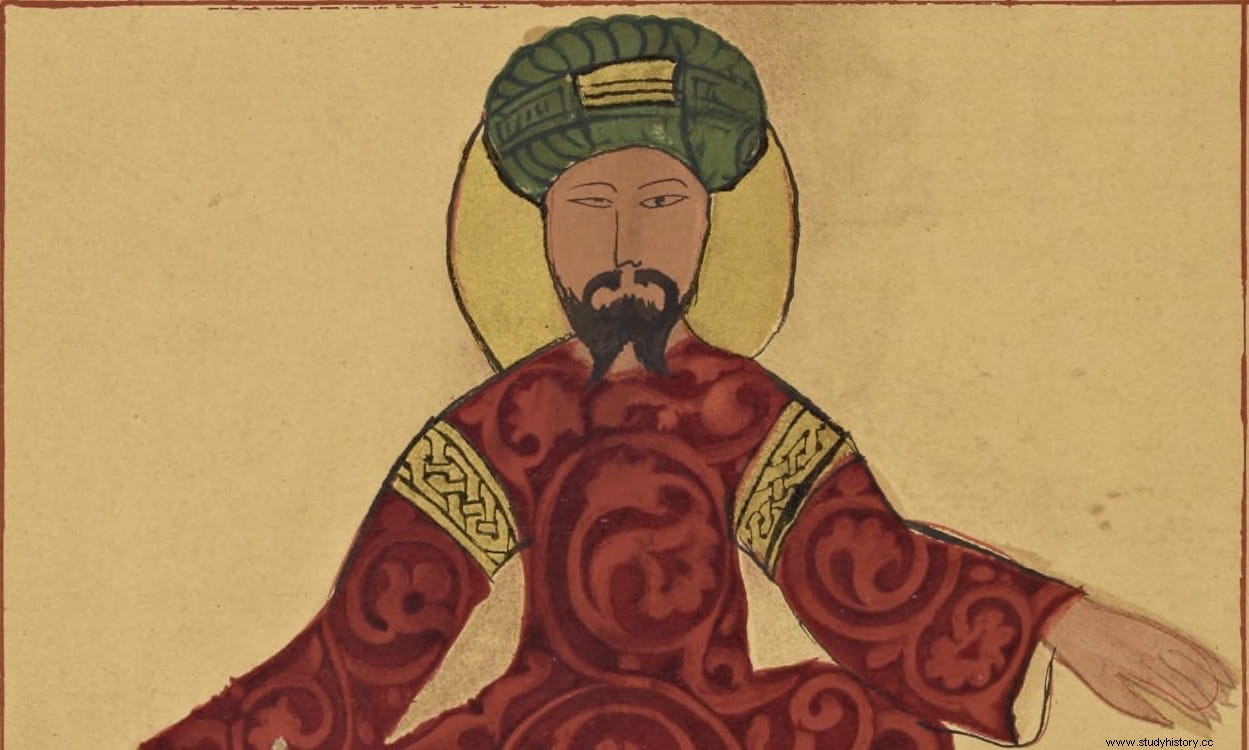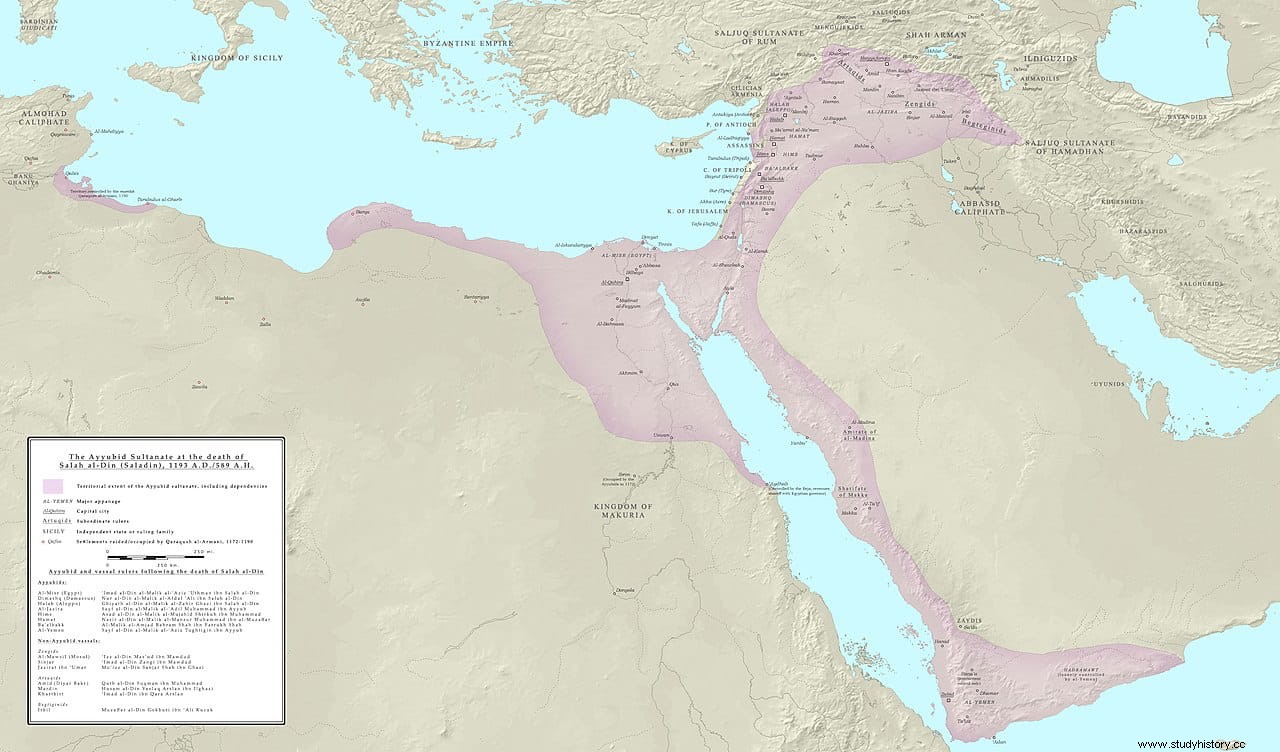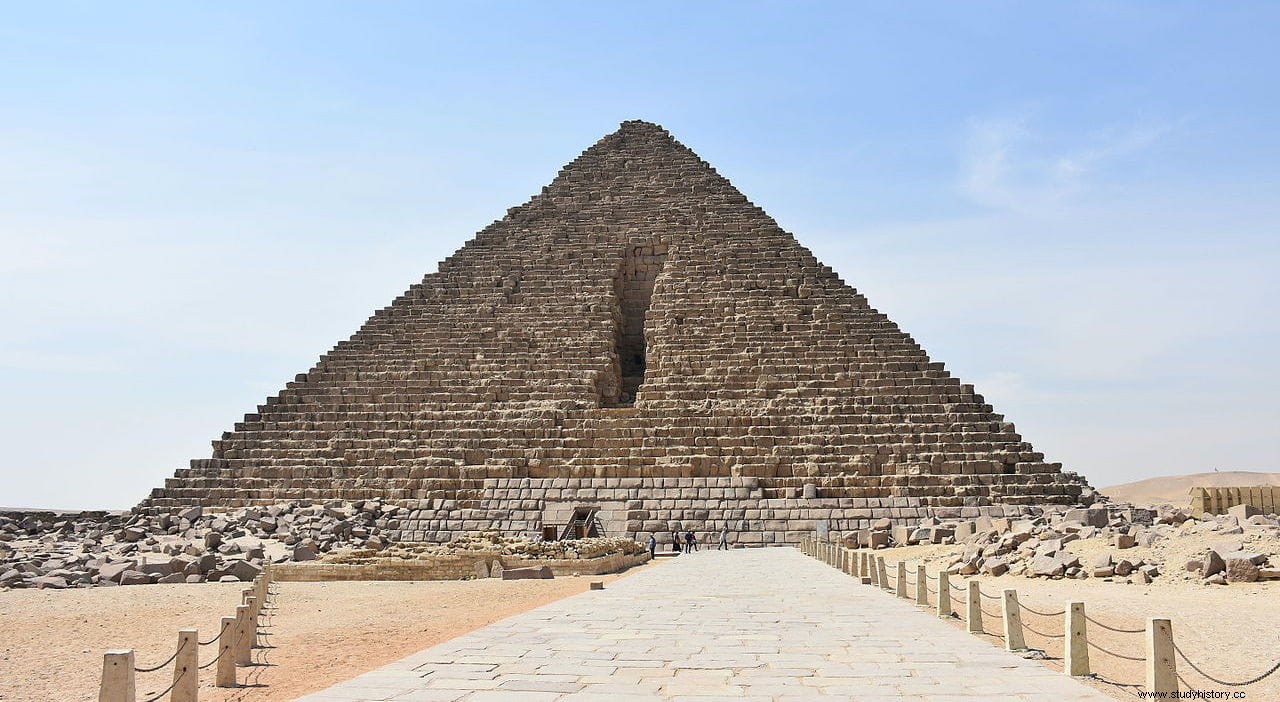Seeing the pyramids of Giza in person is an exciting experience that also allows you to see some fascinating details. One of them is the vertical crack that has the north face of the smaller one, Mycerinus, just above the entrance. Its origin is really curious:it is the scar left by the attempt to dismantle it undertaken by the Muslims in the 12th century and which, luckily, they gave up when they realized the magnitude of work that it would require (and that they had started with the smallest ). The person responsible for that crazy project was Al-Aziz Uthman, Ayyubid sultan of Egypt and son of the famous Saladin.
Micerino is the Hispanicization of Mykerinos, the Hellenized version of the name of Menkaura, a pharaoh of the IV dynasty, son of Khafre, grandson of Cheops and father of Shepsekaf, who would be his successor. Like the first two, he built a pyramid to serve as a tomb (the offspring preferred to be buried in a mastaba, breaking tradition) at the end of his reign, which lasted twenty-eight years, from 2514 BC. to 2486 BC The exact dates on which the work was carried out are not known and Egyptologists only point out that it must have been completed in the 26th century BC.
This monument, also associated with a funerary temple, was named Netjer-er-Menkaure ("Menkaura is divine") and originally measured 65.5 meters in height by 108.5 in base, adding a total of 235,183 cubic meters. It is made of red granite that was once covered with a white layer of limestone from Tura, now lost (except for the first courses at the base), which is why its height has dropped to 61 meters, as the pyramidon at the vertex is missing. On the south face it is accompanied by three smaller pyramids, each with a temple, belonging to the pharaoh's wives. At the end of the Egyptian Empire, a multitude of legends arose around the pyramids of Giza, relating them first to the myth of Hermes and later to the biblical account of Noah.

As they were also supposed to be the hiding place of fabulous treasures and secrets of science and literature, as collected in a story of The Thousand and One Nights (and confirmed by the historian Al-Massudi) in which the caliph Al-Mamun opened a breach in Kéops to search for them in the 9th century (that breach exists, although it is believed that it was made by tomb desecrators already in the Pharaonic era) , the emir Karakush caused considerable damage to the pyramid of Khafre and its subsidiaries looking for those riches. This is how the medieval scholar Abd al-Latif al-Baghdadi tells it in his work Journey to Egypt . But for destruction, the ones caused by Al-Aziz, as we said at the beginning.
Al-Malik Al-Aziz Osman bin Salahadin Yusuf, which was his full name, was born in Cairo in the year 1171. His mother is unknown, since Saladin had several wives or concubines about whom little is known and the one that can be considered the main one, Ismat ad-Din Khatun (better known as Asimat, daughter of the regent of Damascus and who had become the widow of Nur ad-Din, governor of Syria, when Saladin asked for her hand to keep the city) she never fathered offspring with her husband.

What we do know is that he had up to seventeen brothers, among whom his father divided the empire before he died in 1193. To the eldest son, Al-Afdal, he left Palestine and Syria, where he was governor, which included Damascus, the jewel of the crown and, predictably, a reason for discord. Al-Aziz was given Egypt. Al-Zahir, the third son, was emir of Aleppo and Mosul from the age of fifteen and that was his inheritance. Al-Adil, Saladin's brother and great general whom the Crusaders called Safadin in allusion to his title of Sayf ad-Din (Sword of Faith), received Kerak. And Turanshah, Saladin's younger brother, received Yemen, a land that he really didn't like.
In reality, Saladin's wish would have been to appoint a single successor and for all other relatives to swear allegiance to him in order to hold the empire together. The person chosen for this was Al-Afdal Ali, who had fought at his side against Richard the Lionheart during the Third Crusade and, therefore, presented himself as the head of the Ayyubid dynasty, the lineage of Kurdish origin that Saladin inaugurated in Egypt after proclaim himself sultan and displace the Fatimids. However, Al-Afdal was not as good a ruler as he was a warrior; on assuming power he dismissed all his father's ministers, sowing indignation among them and causing them to seek refuge in Egypt.
There they asked Al-Aziz to march against his brother and replace him and he accepted, starting a rebellion in 1194. His uncle Safadin tried to mediate between the two but he did not get more than a one-year truce, after which they returned to face. For a while, Al-Afdal was able to resist but Safadin fed up with his incompetence and allied himself with Al-Aziz to take Damascus from him; Al-Afdal was banished to Salkhad, in the Hauran region, where he waited. Meanwhile, his brother became the undisputed owner of the Ayyubid empire, which included Syria, Upper Mesopotamia, Egypt, and Arabia.

Something especially meritorious if one takes into account that when assuming his inheritance he had had to face a series of rebellions. On the one hand, the emirs of Mosul, who were Zanguis and, therefore, from a different dynasty:the Oguz, also Muslim but of Turkish origin and who had been a vassal of the Seljuk Empire (the Turkish-Persian Sunni sultanate that had collapsed in 1194). The Zanguis had been subdued by Saladin and now that he was gone they saw an opportunity to free themselves from Ayyubid rule.
Also up in arms were the emirs of Korasan (a region that encompassed northeastern Iran, part of Afghanistan, and much of central Asia) and the Artukids, a Turkmen dynasty that once ruled over eastern Anatolia, northern Syria, and northern Syria. Iraq but to which the Ayyubids had constrained the Iraqi south. Once the danger had been overcome and his brother had been overthrown, Al-Aziz could consider himself the master of the Ayyubid empire; At least in theory, because in practice it was his uncle Safadin who held the reins in Damascus.
Al-Aziz hardly had time to enjoy his position, as he perished in 1198 after falling from his horse during a hunt. But two years earlier he had felt powerful enough to make a symbolic display of that position:demolish the pyramids of Giza, testimony to a pagan era that had yielded to Islam, starting with Mycerinus, as it was the smallest . Even so, the technical difficulties proved to be greater than expected, since if building such imposing monuments had required enormous programming and coordination work, it was clear that dismantling them was not going to be a minor operation.

In practice, the gangs of workers hired for this purpose could not move more than two blocks a day. The method used, based on pushing them with wedges and levers to later drag them with ropes, so that they would fall under their own weight, was counterproductive. The large fallen stones remained half-buried in the sand and they had to be removed from there as well if they were to be used as a quarry (that was the original idea), and to have clear access, but due to their size it was impossible, since once down there was no help from gravity, so there was no choice but to break them into pieces.
Now, that wasn't easy either, so after eight months, when he had only been able to make a crack in the north face of the pyramid, he gave up the effort, leaving it as impossible. The force of Islam crashed before the hearth of pharaonic polytheism, we could say, parallel to the end of Al-Aziz. Because after the hunting accident that cost him his life, his twelve-year-old son, Al-Mansur Mohammed, had to accept that his exiled uncle Al-Afdal returned to be regent of Egypt while he did not reach the majority old. Al-Afdal, desirous of revenge for those years postponed, joined his other brother, Al-Zahir, to get rid of Safadin, whom they laid siege to in Damascus.
But he, with the help of his son Al-Jamil, broke the siege in 1199 and took the war to Egypt, seizing it from his nephew and proclaiming himself sultan. al-Afdal ended up arguing with Al-Zahir and threw in the towel, accepting his uncle's offer to hand him over the government of several cities, including Samosata and Saruj (in Anatolia) and others further afield, in Mesopotamia. Al-Zahid continued to fight but ended up accepting Safadin's authority in 1202. Al-Afdal would stage a new rebellion attempt in 1218 with the help of Kaikaus I, Seljuk sultan of Rüm (central Anatolia). Once again, he fell out with his ally and left, dying in 1225.
